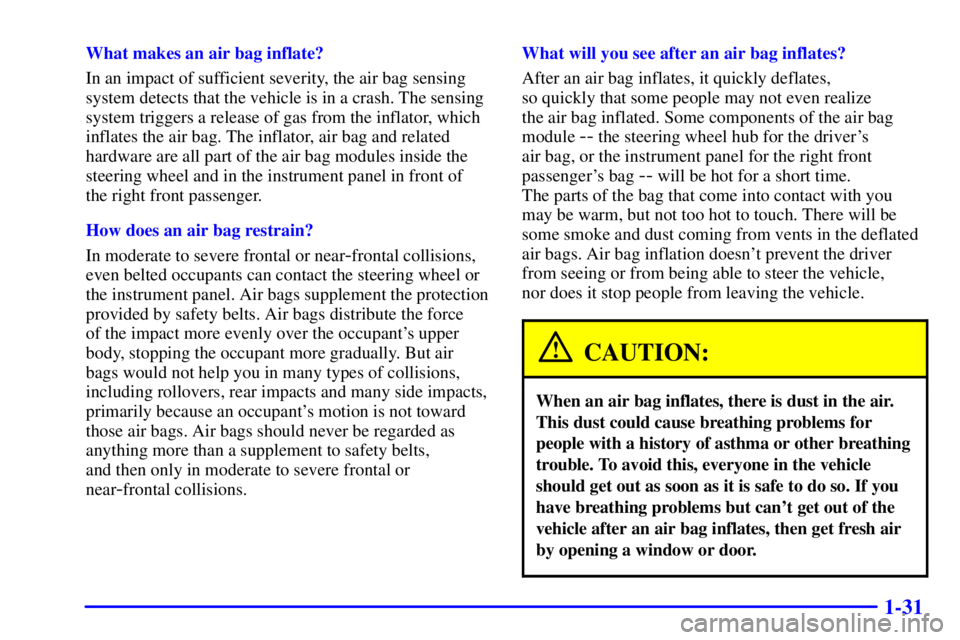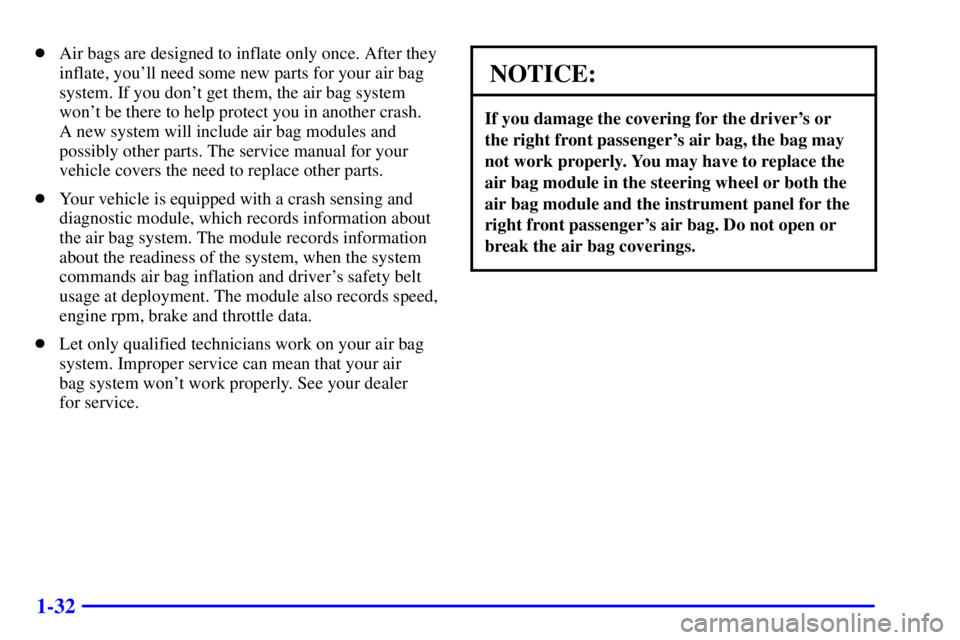Page 5 of 411

iv
Vehicle Damage Warnings
Also, in this book you will find these notices:
NOTICE:
These mean there is something that could damage
your vehicle.
In the notice area, we tell you about something that can
damage your vehicle. Many times, this damage would
not be covered by your warranty, and it could be costly.
But the notice will tell you what to do to help avoid
the damage.
When you read other manuals, you might see
CAUTION and NOTICE warnings in different
colors or in different words.
You'll also see warning labels on your vehicle.
They use the same words, CAUTION or NOTICE.
Vehicle Symbols
Your vehicle may be equipped with components and
labels that use symbols instead of text. Symbols,
used on your vehicle, are shown along with the text
describing the operation or information relating to a
specific component, control, message, gage or indicator.
If you need help figuring out a specific name of a
component, gage or indicator reference the following
topics in the Index:
�ªEngine Compartment Overviewº
�ªInstrument Panelº
�ªComfort Controlsº
�ªAudio Systemsº
Also see ªWarning Lights and Gagesº in the Index.
Here are some examples of symbols you may find on
your vehicle:
Page 21 of 411
1-14
or the instrument panel ...or the safety belts!
With safety belts, you slow down as the vehicle does.
You get more time to stop. You stop over more distance,
and your strongest bones take the forces. That's why
safety belts make such good sense.
Page 33 of 411
1-26
If it says AIR BAG on the middle part of the steering
wheel and AIR BAG on the instrument panel in front of
the right front passenger's seat, your vehicle has two air
bags
-- one air bag for the driver and another air bag for
the right front passenger.If it says AIR BAG on the middle part of the steering
wheel but it doesn't say AIR BAG on the instrument
panel in front of the right front passenger's seat, your
vehicle has an air bag for the driver only.
If it says AIR BAG on the middle part of the steering
wheel, but there is no right front passenger seat,
your vehicle has an air bag for the driver only.
If it doesn't say AIR BAG on the middle part of the
steering wheel, your vehicle doesn't have air bags.
Frontal air bags are designed to help reduce the risk of
injury from the force of an inflating air bag. But these
air bags must inflate very quickly to do their job and
comply with federal regulations.
Page 35 of 411
1-28
If your vehicle has an air bag for the right front
passenger, please read this:
CAUTION:
Anyone who is up against, or very close to, any
air bag when it inflates can be seriously injured
or killed. Air bags plus lap
-shoulder belts offer
the best protection for adults, but not for young
children and infants. Neither the vehicle's safety
belt system nor its air bag system is designed
for them. Young children and infants need the
protection that a child restraint system can
provide. Always secure children properly in your
vehicle. To read how, see the part of this manual
called ªChildren.º
United States Canada
There is an air bag readiness light on the instrument
panel, which shows AIR BAG or the air bag symbol.
The system checks the air bag electrical system for
malfunctions. The light tells you if there is an electrical
problem. See ªAir Bag Readiness Lightº in the Index
for more information.
Page 36 of 411
1-29 How the Air Bag System Works
Where are the air bags?
The driver's air bag is in the middle of the steering wheel.
The right front passenger's air bag is in the instrument
panel on the passenger's side.
Page 38 of 411

1-31
What makes an air bag inflate?
In an impact of sufficient severity, the air bag sensing
system detects that the vehicle is in a crash. The sensing
system triggers a release of gas from the inflator, which
inflates the air bag. The inflator, air bag and related
hardware are all part of the air bag modules inside the
steering wheel and in the instrument panel in front of
the right front passenger.
How does an air bag restrain?
In moderate to severe frontal or near
-frontal collisions,
even belted occupants can contact the steering wheel or
the instrument panel. Air bags supplement the protection
provided by safety belts. Air bags distribute the force
of the impact more evenly over the occupant's upper
body, stopping the occupant more gradually. But air
bags would not help you in many types of collisions,
including rollovers, rear impacts and many side impacts,
primarily because an occupant's motion is not toward
those air bags. Air bags should never be regarded as
anything more than a supplement to safety belts,
and then only in moderate to severe frontal or
near
-frontal collisions.What will you see after an air bag inflates?
After an air bag inflates, it quickly deflates,
so quickly that some people may not even realize
the air bag inflated. Some components of the air bag
module
-- the steering wheel hub for the driver's
air bag, or the instrument panel for the right front
passenger's bag
-- will be hot for a short time.
The parts of the bag that come into contact with you
may be warm, but not too hot to touch. There will be
some smoke and dust coming from vents in the deflated
air bags. Air bag inflation doesn't prevent the driver
from seeing or from being able to steer the vehicle,
nor does it stop people from leaving the vehicle.
CAUTION:
When an air bag inflates, there is dust in the air.
This dust could cause breathing problems for
people with a history of asthma or other breathing
trouble. To avoid this, everyone in the vehicle
should get out as soon as it is safe to do so. If you
have breathing problems but can't get out of the
vehicle after an air bag inflates, then get fresh air
by opening a window or door.
Page 39 of 411

1-32
�Air bags are designed to inflate only once. After they
inflate, you'll need some new parts for your air bag
system. If you don't get them, the air bag system
won't be there to help protect you in another crash.
A new system will include air bag modules and
possibly other parts. The service manual for your
vehicle covers the need to replace other parts.
�Your vehicle is equipped with a crash sensing and
diagnostic module, which records information about
the air bag system. The module records information
about the readiness of the system, when the system
commands air bag inflation and driver's safety belt
usage at deployment. The module also records speed,
engine rpm, brake and throttle data.
�Let only qualified technicians work on your air bag
system. Improper service can mean that your air
bag system won't work properly. See your dealer
for service.
NOTICE:
If you damage the covering for the driver's or
the right front passenger's air bag, the bag may
not work properly. You may have to replace the
air bag module in the steering wheel or both the
air bag module and the instrument panel for the
right front passenger's air bag. Do not open or
break the air bag coverings.
Page 72 of 411

2-
2-1
Section 2 Features and Controls
Here you can learn about the many standard and optional features on your vehicle, and information on starting,
shifting and braking. Also explained are the instrument panel and the warning systems that tell you if everything is
working properly
-- and what to do if you have a problem.
2
-2 Windows
2
-4 Keys
2
-6 Door Locks
2
-8 Keyless Entry System (If Equipped)
2
-16 Rear Doors
2
-18 Theft
2
-19 Passlock�
2-20 New Vehicle ªBreak-Inº
2
-20 Ignition Positions
2
-21 Starting Your Gasoline Engine
2
-23 Engine Coolant Heater (If Equipped)
2
-24 Automatic Transmission Operation
2
-27 Parking Brake
2
-28 Shifting Into PARK (P)
2
-30 Shifting Out of PARK (P)
2
-31 Parking Over Things That Burn2
-32 Engine Exhaust
2
-32 Running Your Engine While You're Parked
2
-33 Locking Rear Axle (If Equipped)
2
-33 Horn
2
-34 Tilt Wheel (Option)
2
-34 Turn Signal/Multifunction Lever
2
-41 Exterior Lamps
2
-43 Interior Lamps
2
-45 Mirrors
2
-49 Storage Compartments
2
-49 Cigarette Lighter/Ashtray
2
-50 Sun Visors
2
-52 The Instrument Panel -- Your
Information System
2
-53 Instrument Panel Cluster
2
-55 Warning Lights, Gages and Indicators